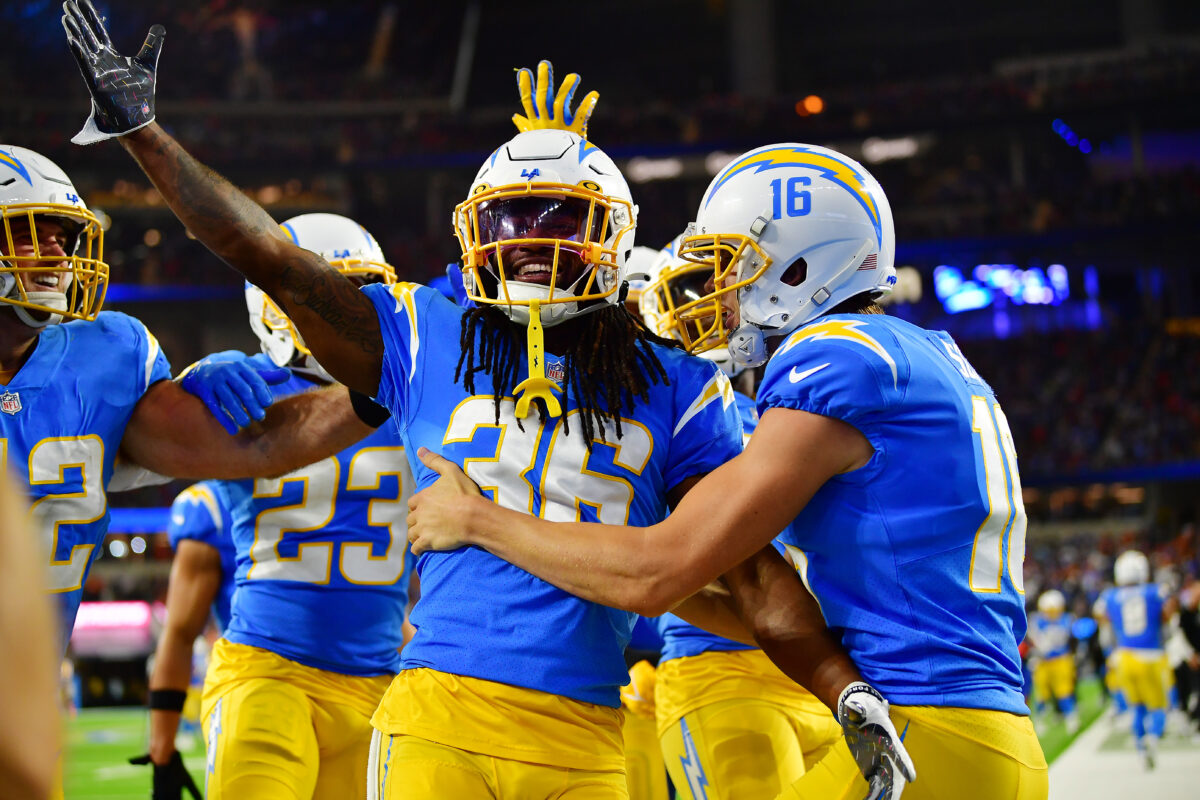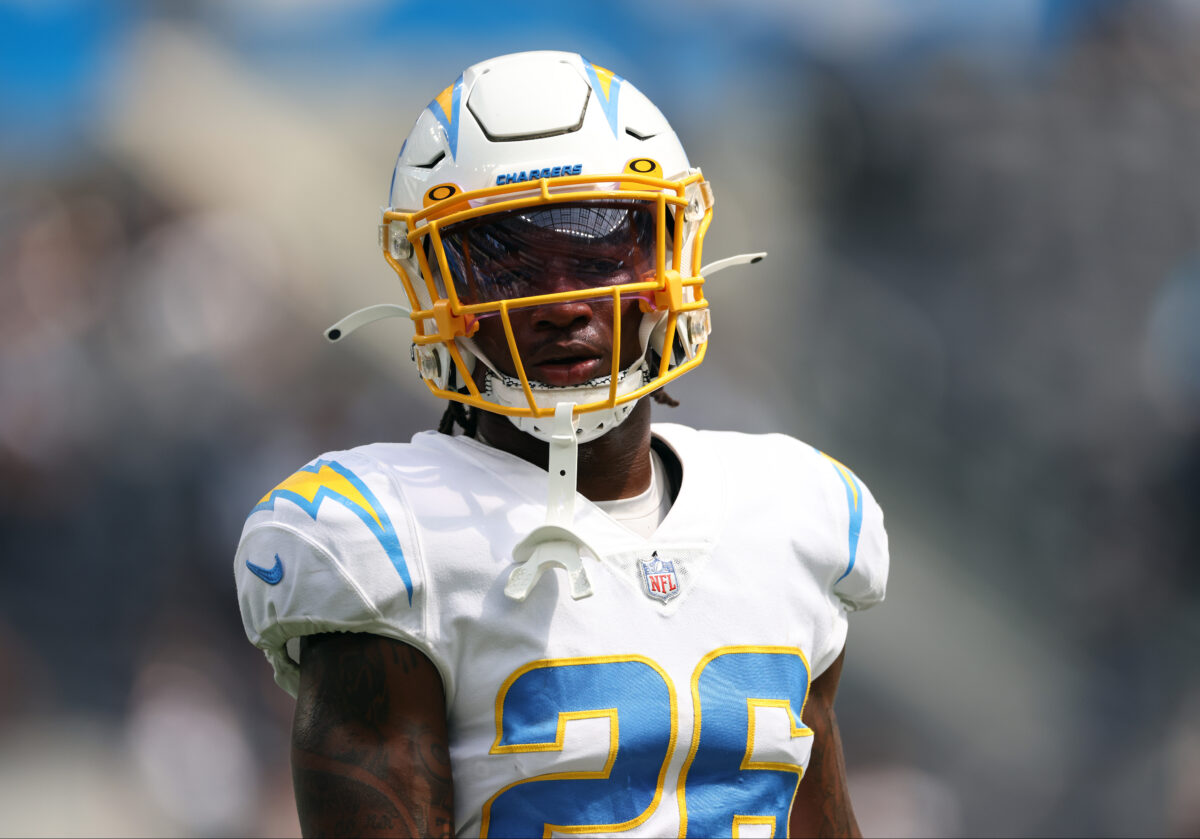The Chargers finally seem to have a competent set of special teams for the first time in what feels like a decade, led by new special teams coordinator Ryan Ficken.
Some things have been working from the beginning, while Ficken has made some in-season changes that have upped the performance of the whole squad. In some areas, there’s still some room for improvement.
In this *special* film room, we’ll cover it all.
Ja’Sir Taylor has been a stud
Taylor has had a flash play in nearly every game, primarily as a gunner on the punt team. It all started in Week 1, where the rookie timed a tackle on Raiders punt returner Hunter Renfrow to perfection:
— alex katson (@alexkatsonfilm) October 27, 2022
Taylor’s 4.39 speed is on display here: by working the inside leverage of the double team and burning past both Raiders blockers, Taylor gives himself an open lane to make the tackle on Renfrow. It comes with danger, too, however, as a missed tackle would leave Renfrow with a chance to break the play to the outside for a big return.
Let’s fast forward to the obvious play Taylor has made this season: his forced fumble via shove to a Broncos punt blocker that all but won the Chargers the game in overtime.
— alex katson (@alexkatsonfilm) October 27, 2022
Taylor and Ficken said postgame that they had seen this look from Denver and talked about using it to LA’s advantage. The rookie executes this one, leaving Deane Leonard to fall on the fumble.
What I like about this play, beyond the fact that it won the Chargers the Monday night game, is that this same setup occurs in the Jacksonville game, with Taylor just barely failing to convert it into a turnover play.
— alex katson (@alexkatsonfilm) October 27, 2022
Taylor’s blocker follows him down the field, coming within a yard or so of Jaguars punt returner Jamal Agnew. Taylor executes one final push as the ball arrives, but the blocker, cornerback Chris Claybrooks, manages to stumble just clear of Agnew as he hauls in the fair catch. This play came on the first Chargers drive of the game, and a turnover play could’ve turned the tide of what ended up being a 38-10 blowout loss for LA. We might’ve also been talking about Taylor’s performance much earlier.
The one (small) thing I’ve had an issue with when it comes to Taylor is that he seems to down the ball too early without giving JK Scott’s punts enough time to bounce further toward the goal line. He did it twice against Seattle, this one being more egregious:
— alex katson (@alexkatsonfilm) October 27, 2022
It’s hard to tell from either the wide or end zone angles which way Scott’s punt would’ve bounced had Taylor allowed it to touch the ground, but footage after the play shows Taylor looking frustrated and having a brief conversation with Chris Rumph, who looked like he was ready to see how the ball bounced.
Later in this same game, Taylor and Leonard showed how quickly they learn:
— alex katson (@alexkatsonfilm) October 27, 2022
This time, the bounce is perfect from Scott. Leonard is the gunner to the near side (bottom of the screen) and overruns the punt, which is fine because of the field position and returner’s clearout. Taylor arrives at the scene late from the top of the screen (circled), and almost downs it as both he and the ball round their path off. To his credit, he recognizes the bounce and teams up with Leonard to down it at the 2, eventually leading to the Sebastian Joseph-Day safety in this game.
This quarter-to-quarter development got me thinking: is there something from a previous week that made Taylor think the first two punts in the Seattle game were going to take bad bounces? And indeed, I found a clip from Week 2:
— alex katson (@alexkatsonfilm) October 27, 2022
On this one, you can see Taylor recognizes that Chiefs punt returner Skyy Moore has no interest in fielding the incoming kick. As a result, Taylor turns towards the goal line, setting up to harness the loose ball before it crosses into the end zone for a touchback. Instead, Scott’s punt bounces backward, forcing Taylor to reverse course and losing the Chargers eight or nine yards of field position. In later weeks, you can see Taylor hesitate to commit to taking the goal line route, instead opting to trust his ability to track the ball on a single bounce to save those yards. Consider if Taylor plays this Chiefs punt the same way he does the ones in Seattle: he probably hauls it in at about the seven instead of Amen Ogbongbemiga downing it at the 14.
Deane Leonard supplants Michael Davis
We’ve mentioned Leonard a couple of times when showcasing these plays from Taylor, and the rookie tandem has by far been the best set of Chargers gunners to date. Before Leonard took over, L.A. had Michael Davis opposite of Taylor, which resulted in plays like this:
— alex katson (@alexkatsonfilm) October 27, 2022
Davis doesn’t quite have the field awareness in this clip that the rookies have shown this season, and it hurts the team with a fair catch interference penalty here as Davis bumps into the Texans’ returner.
Davis also overruns a punt against Denver two weeks later, missing an opportunity to recover a muffed punt from Broncos returner Montrell Washington:
— alex katson (@alexkatsonfilm) October 27, 2022
Credit to Essang Bassey (I think), who does a good job making sure Davis stays to his outside for this entire play to ensure that Davis can’t make a tackle on a potential return. But film from the Chargers’ other games shows that Taylor and Leonard engage with this blocker as they approach the return man, rarely allowing a play like this to go unpunished. You can even see Taylor get to this loose ball before Davis does, despite starting on the opposite side of the field because of the way he fights through and around his blocker. In the end, L.A. misses an opportunity to generate a turnover as Washington falls back on the ball.
Davis has also had a few issues as a kickoff coverage man, most evident in this same Denver game:
— alex katson (@alexkatsonfilm) October 27, 2022
Technically, Davis does his job here. He absorbs a block, forces Washington to make a decision, and stalls for long enough that his teammates rally to the ball and stop Washington short of the 30. But Davis has to finish this tackle. He’s squared up on the rookie and is positioned to force Washington to the inside, but instead can’t quite wrap up and gets beaten by a spin move back to the outside.
Compare this to a play Leonard makes against Seattle in kick coverage:
— alex katson (@alexkatsonfilm) October 27, 2022
Leonard perfectly splits two blocks as he runs his lane on the opening kickoff, leaving him free to stop Seahawks returner, Dee Eskridge, at his 19-yard line. Seattle miscommunicates about whose responsibility it is to slow the rookie down. Leonard has had a few plays like this littered on his tape and the Seattle game was his best performance to date. With another week of coaching during the bye week and a full week of work at gunner now that Davis is slated to start at corner, Leonard should round into form as an above-average gunner next to the already above-average Taylor.
Examining DeAndre Carter
Out of kickoff returners with at least eight returns this season, Carter is only 15th in average return yards out of 18 eligible players. This is after Carter was 8th in average return yards out of 38 players with at least ten kickoff returns last season in Washington, while former Chargers returner Andre Roberts was 5th. Something about the return game isn’t working, but is it Carter or something more systemic?
I tend to lean towards the latter. Carter is certainly leaving yards on the table occasionally, but sometimes he has nothing he can do. His primary lead blocker is failing him:
was going thru some clips to investigate why DeAndre Carter hasn't been living up to expectation as a return man and found this from Week 4. if Horvath holds this block for even half a second, Carter has a lane and looks like he'd only have the K to beatpic.twitter.com/CE2rorGCCX
— alex katson 🇯🇵 (@alexkatson) October 27, 2022
Here, if Zander Horvath sustains this block for even an instant, Carter has a seam between the rookie and Joshua Kelley. Nobody else on the Texans is in position to make a play, meaning Carter would be sprung free with only the kicker to beat on his way up the field. Instead, Horvath instantly gets beat by running back Dare Ogunbowale. Carter tries to cut back to what is now a closing lane, but Horvath’s momentum has brought him into Carter’s path, resulting in a tackle by the fullback that’s cleaned up by the Texans.
Later in this game, we have a similar problem, this time with Joshua Kelley:
another example from the Texans game: Joshua Kelley doesn't see this defender immediately get off an initial block and climbs through this hole. if he turns his body like 15 degrees to even chip #44, Carter has another 10-15 yardspic.twitter.com/VEsJMCEIyy
— alex katson 🇯🇵 (@alexkatson) October 27, 2022
Kelley turns his eyes upfield before seeing that Troy Reeder has missed his block on Texans linebacker Jalen Reeves-Maybin. Instead, the running back skirts past him to pave the way for Carter through what he perceives as a developing path to the sideline and into Texans territory. If he moves his head a few degrees to the right and recognizes Reeves-Maybin slinking past him and throws a block there instead, it gains Carter an extra 10-15 yards, even if he can’t spring it for a huge return. From the end zone angle, it looks like Kelley should see the linebacker – after all, you can see Reeves-Maybin get a bit skinnier as he gets past the running back.
In short: let Ja’Sir Taylor keep doing what he’s doing and get Deane Leonard in there next to him in the punt game. In the kickoff game, let’s not be so quick to blame Carter for the struggles – there’s still work to be done on the blocking front.

